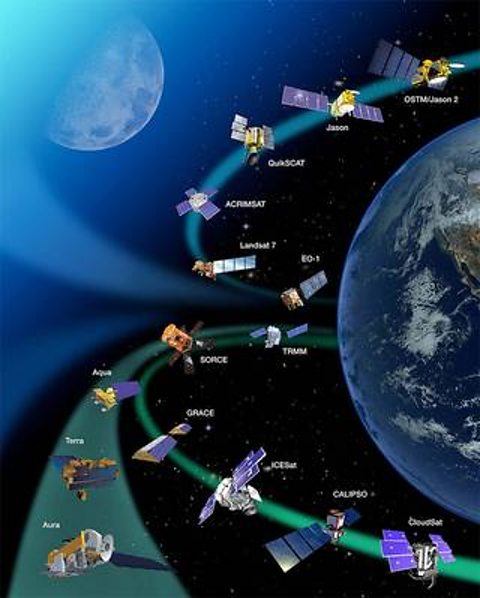Satellites

A satellite is a moon, planet, or machine which orbits a planet or a star. The Moon is the Earth's natural satellite, but we also have thousands of artificial satellites that have been put into space orbiting the Earth.
An artificial satellite orbits the Earth by travelling at a high velocity at a set distance above the planet.
One of the most common types of satellite is one that travels around the Earth at the same rate as the Earth rotates on its axis. These satellites are known as “geostationary” and have to be placed at a height of 36,000 km and at a velocity that means the satellite takes 24 hours to complete one revolution of the Earth.
This means that the satellite appears to “hover” above the same point on the Earth’s surface. A receiver can be pointed at this satellite, allowing for a link for information to pass to be established. These geostationary satellites are used for communication, weather prediction, and GPS.
Satellites that orbit closer to the Earth can see more detail, but have to travel at a greater velocity in order to stay in orbit. Some are so close that on a clear night you can see these satellite pass by with the naked eye.
Conversely, if a satellite is further away from the Earth, it only needs a lower velocity to remain in geostationary orbit.
=Why Are Satellites Important?
Artifical satellites either face the Earth, or look out into space.
Those satellites that look out into space play a vital role in the study and understanding of our universe. Without distortion caused by our atmosphere, satellite telescopes in orbit have clearer images from deep space.
add example images from NASA
Those satellites that look towards the Earth can view a large area of the globe, which means they can collect far more data than scientific equipment on the ground. This allows us to study and predict the weather and including predicting and tracking large events such as hurricanes or forest fires. This can help save lives by giving warnings to people in danger.

Many aspects of our day-to-day life are dependent upon satellites:
- Satellites with various detectors and telescopes can observe distant objects and allow us to analyse them in order to increase our knowledge of the Universe in which we live. The Hubble space telescope increased our knowledge of space a great amount, and it's sucessor the James Webb telescope will further our understanding.
- Global Positioning Systems (GPS) allow us to use a phone or other device, such as a sat nav, to determine our location to within a few metres.
- Television networks rely heavily on satellites to transfer signals from one area to another, such as live reporting from major events.
- Our weather forecasts are based upon data taken from satellite systems which have monitored the area around where we live. We can receive very up-to-date images of clouds and such which are then shown on our forecasts.